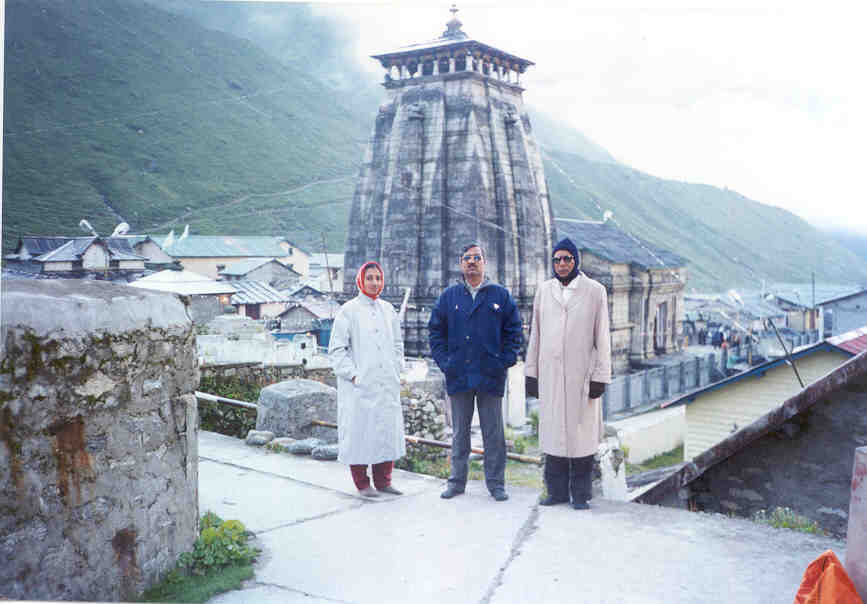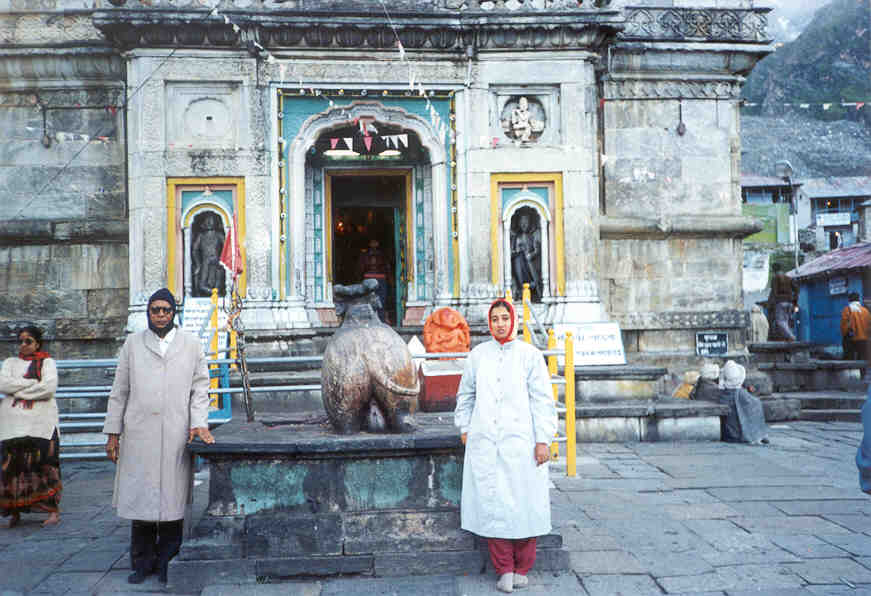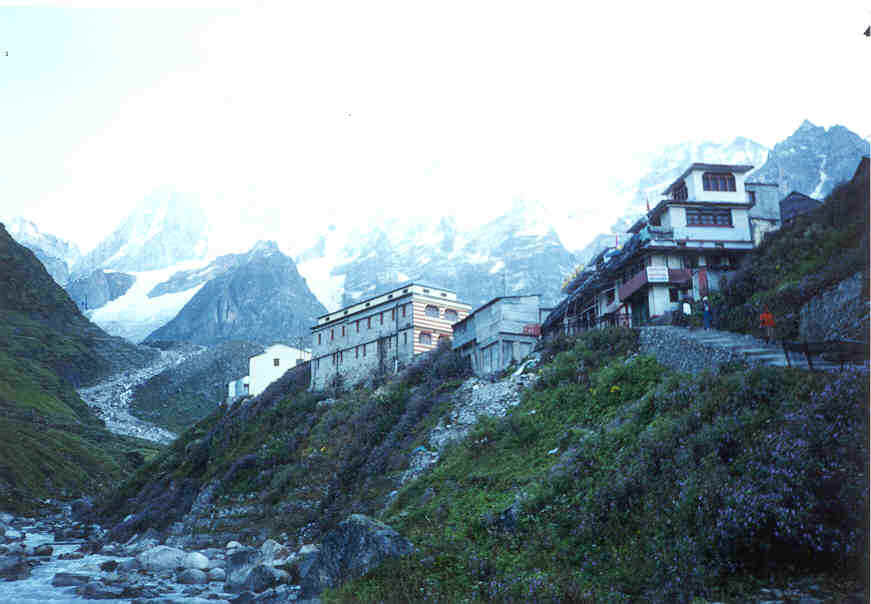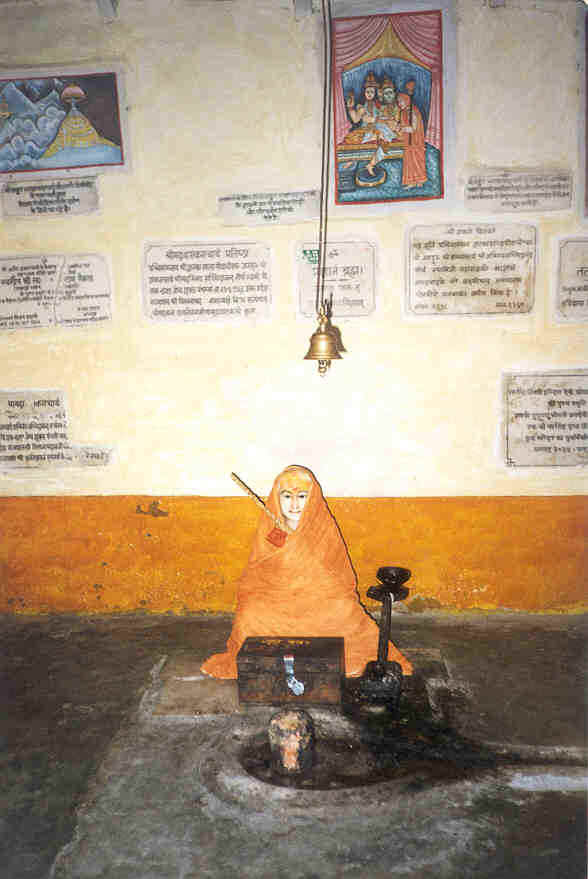Guest writer K. Ram Kumar continues his illustrated journey through
the Himalayas, visiting the ancient shrines at Badrinath, Kedarnath and more. See
also A Himalayan Journey - Part I and Part II.
Kedarnath
Temple is situated at 11500 ft above sea level in the Tehri-Garhwal range
of Hills. Pilgrimage to this abode of Lord Shiva is considered to be the toughest, next
only to Mount Kailash. Kedarnath is also one of the 12 Jyothirlingams
held in reverence. Adi Sankaracharya is said to have worshipped
Shiva here. The Tamil Saint Poets Thirugnansambandar and Sundarar
have sung pathigams in praise of this deity.
(See Also: Abodes of Shiva, 12 Jyotirlinga Shrines
of Shiva, Mount Kailash, All about Shiva)
Antiquity: The age of the temple is
traced to Mahabharatha period. The original structure is believed
to have been built by Pandavas. Janameyjayan, son of Parikshit
Maharaj, is said to have constructed the Mandap (Hall) before sanctum sanctorum. The
present structure is a result of renovations over a period of time.
This moderately sized temple
consists of a sanctum and a hall in front. Outside the temple, in the open sky,
there is a majestic Nandi (Bull – vehicle of Shiva)
facing Shiva. Just at the entrance, there is Vinayaka
- with a human face in a posture of prayer. The mandap, houses the images of Pandavas
and their wife Draupadi – original builders of the temple besides Krishna
(mentor of Pandavas – a reincarnation of Vishnu)
and Kunti (mother of Pandavas). While Yudhistir,
eldest of the Pandavs stands symbolising Dharma , Arjun is dressed for
performing penance. Others – Bhim, Nakul
& Sahadev stand duly armed with their respective traditional arms.
In addition, there is also a
small bull and Swami Veerbhadra inside the temple. Just before the
sanctum sanctorum, an image of KedarGauri , consort of Shiva is located facing west. Shiva
is worshipped in the form of a Shiva Lingam, facing South. There is also
a small temple for Bhairav, to the south of main temple, who is
said to guard the Kedarnath temple when it is closed for worship during winter.


Legend associated
with this temple: After winning the Kurukshetra war, Pandavas
felt remorseful for having killed thousands of lives including those of their cousins. In
order to seek salvation from the sins of war, they sought the advice of their mentor, Krishna.
Krishna advised them to worship Shiva. Pandavas
searched for Lord Shiva in the Shivalik mountains
in the Tehri - Garhwal region.
Shiva led them to this site
and here, assumed the form of Bull and started grazing amongst the cattle. The Pandavas
devised a ruse, to seek Shiva, who had hidden himself amidst a
flock of cattle. At dusk, when the cattle were taken back to their shelters, Bhim
– gigantic in stature , strongest and courageous of Pandavas
stretched his legs across the mountains so that cattle could pass through his legs.
As suspected, Shiva,
in bull form refused to do so and instead sank himself into the earth. Realising quickly
that this was the play of Shiva, Bhim bent downwards and could catch hold of
the hump (back portion of the bull). Shiva, pleased with the determination of
Pandavas, blessed them and granted them salvation from their sins. The hump, in conical
form, is worshipped as Shiva (in the form of a Shivalingam).
Parvathi is also believed to have
performed penance here to become integral part of Lord Shiva – Ardhanareeswar
Swaroopam or form.
(see also
Tiruchengode Ardhanareeswarar Temple)

On the background to
this temple is Chaugambika Hills (called as Velliangiri
in Tamil) – fully snow clad peaks. These range of mountains are believed to be the
beginning of Himalayas, where Mount Kailash is situated. It is also believed to be the
path towards Swarg (Heaven). Pandavas are believed to
have attempted to go to Heaven through this route. Legend has it that while all died
enroute, only Yudhistir – representing the symbol of Dharma
and his dog managed to reach Heaven in the human form.
Being in the Himalayan range, winter is
severe and no continuous habitation is possible at Kedar. Hence the worship is restricted
to six months. The temple is closed on the first day of Kartik (Oct- Nov)
and reopened in Vaisakh (Apr-May). During the period of closure, the
temple remains submerged in snow and regular poojas are conducted at Ukkhimath.
It is believed that during winter, Divine beings perform poojas to Lord Shiva as is being
done by Humans- earthlings during summer.

On the way to the
temple is "Uthank Kund" – a perennial water source. It is believed that
drinking this water as prasad from this Kund, will only complete worship at Kedar. Similar
to Badrinath, Adi Sankara is said to have worshipped here and formulated
the worship protocols. It is further said that Adi Sankara attained Samadhi
here (no authentic proof is available) and to symbolise this is the Samadhi (final
resting-place) located behind the Kedarnath temple. As prescribed by Adi
Sankara, the Chief Priest of this temple is a person from Kannadiga Lingayat community
(from the State of Karnataka). The Chief Priest is required to be strict bachelor.
Worship Protocols:
The services offered to Lord Shiva
include Suprabadh (at 7 am) followed by Balbhog, Mahaabishek,
Rudrahishek and Ashotar in the morning and in the evening Shiv
Ashotatram, Sahasranamam and other archanas and in the
end Ekantha Seva & Aarthi at 8 pm.
When the temple is
opened in the morning, devotees are allowed to enter the sanctum to have darshan at
close quarters and also personally perform poojas. Unlike in most of the temples,
devotees are allowed to touch the presiding deity and offer prayers here. It is believed
that touching the idol of Lord Shiva by hand and placing one’s head on the lingam, in
reverence, enables one to achieve Mukthi (salvation) from the sins of living, and
liberates one from the cycles of birth and rebirth.
Annual festivals celebrated include Badri-Kedar
Utsav and Doli Yatra of
Kedarnath.
Associated
Temples
Panch Kedar
When Shiva sank
himself into the earth to escape from Pandavas, Bhim
managed to hold on to the hump. However, it is believed that different parts of the bull
emerged at five different places (including Kedar) as described in Padma
Purana. The mythological description of these Kedars are explained below:
- Kedarnath :
The hump or the hinder part of the bull which
was held by Bhim is worshipped as Lord Shiva.
- Maddhyamaheshvra :
Nabhi or the middle-part of the bull is
worshipped as Lord Shiva. This is located at 21 kms from Ukhimath – the abode for
Lord Kedarnath during winter.
- Tungnath :
The Bahu or hand of the bull is worshipped here
as Lord Shiva. It is located enroute to Badrinath and is 37 kms from Ukhimath, on a
mountain in between Chamouli and Ukkhimath.
- Rudranath: The Mukh or the mouth of the bull is
worshipped as Lord Shiva here. It is about 19 kms from Mandal Chatti.
- Kalpeshwar :
The Jata or the hair of the head of bull is
worshipped as Lord Shiva. This place is located about 8.7 kms from Helang, on the other
side of the river Alaknanda.
TRIYUGINARAYAN : This
is a mythological venue, at a distance of 25 kms from Kedar and at a short trek of 5 kms
from Sonprayag. It is believed that the wedding of Shiva with
Parvathi was solemnised here. An eternal flame, said to be
a witness for the above wedding, burns in front of the temple even today.
Access and Accommodation: Upto
Gaurikund,(14 kms from Kedar) the place is accessible by motorable roads. Regular bus
services and private taxies ply in this route. However the route is prone to landslides
and is difficult to navigate. Thus, any travel during rainy season should be completely
avoided. State road authorities maintain this road. On the entire route, while mountains
follow on the one side, River Mandakini flows in full form on the other side.
The stretch of 14 kms
from Gaurikund to Kedar is very difficult to trek and can covered only by foot or on
ponies (mules) or dolies (palanquin bearers). Nature’s beauty in the entire route
from Rishikesh to Kedar, will be a treat to watch and will be an experience of different
kind which can not be explained.
The nearest airport is Dehradun
– Jolly Grant AirStrip and is located at a distance of 239 kms. Nearest railhead is
situated at Rishikesh – 221 kms from Kedar (of which 207 kms is
motorable upto Gaurikund).
During summer, postal and banking facilities
are available at Kedar. There is also a small Government Dispensary at
Kedar.
Like Badri, non-vegetarian
food and consumption of alcohol is strictly prohibited at Kedar. Local eateries / Dhabhas
offering vegetarian food are available.
Private Hotels, Dharmasalas and Guest House maintained by the
Temple Committee are available for stay.
